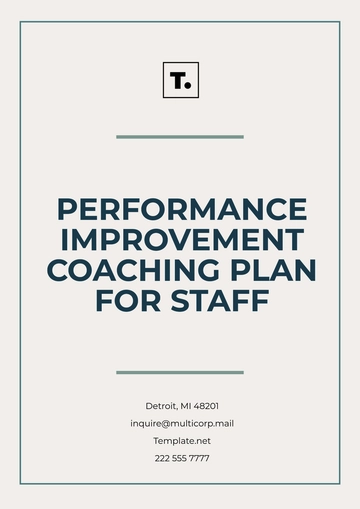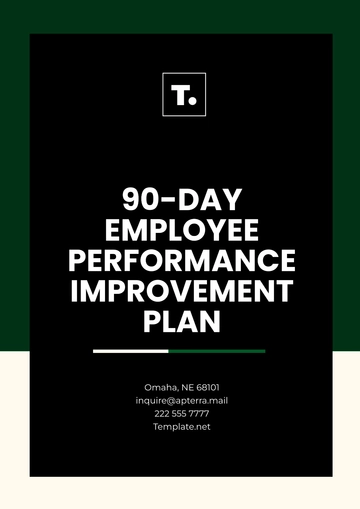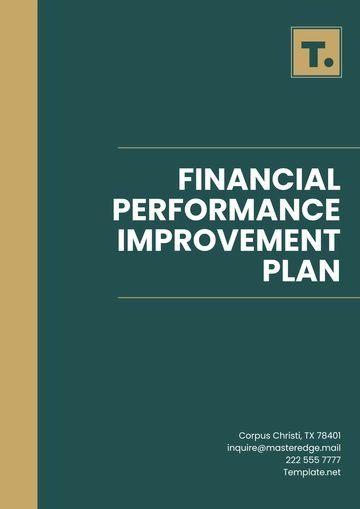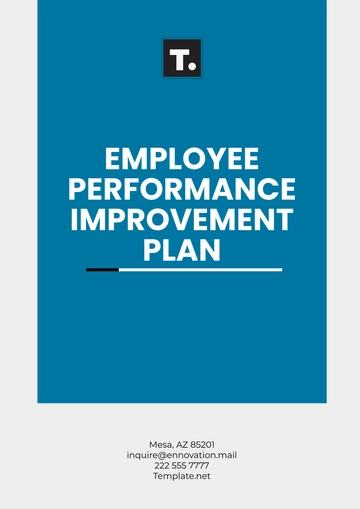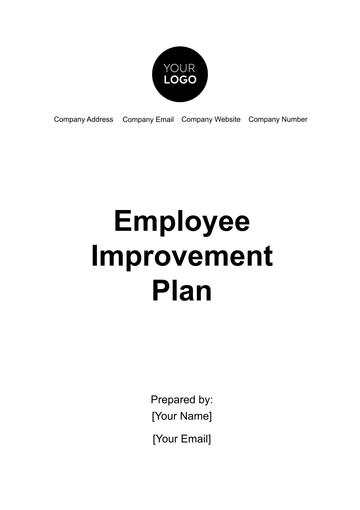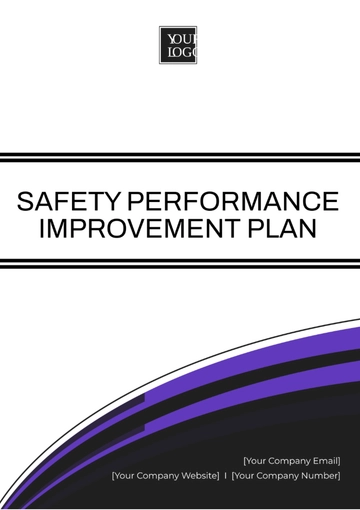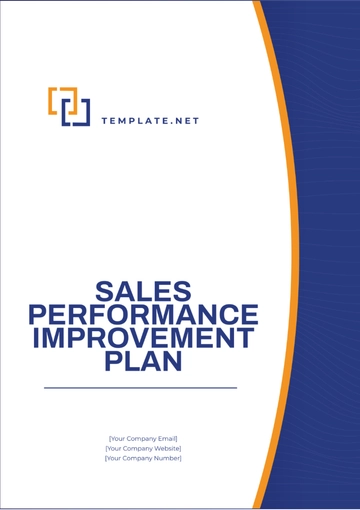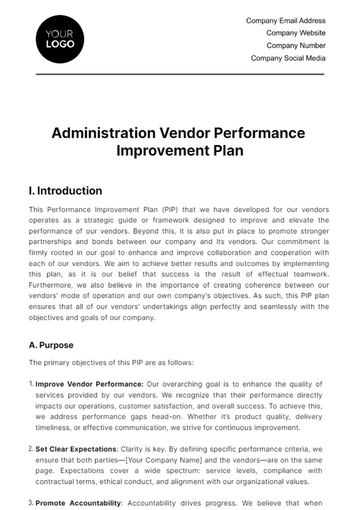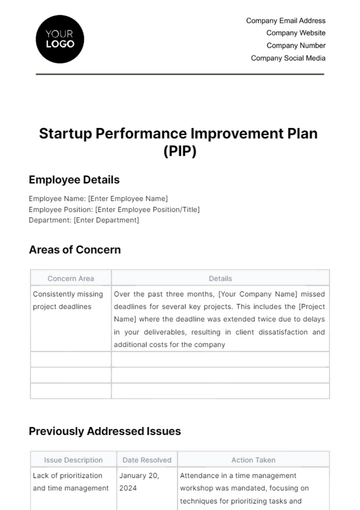Free Administration Vendor Performance Improvement Plan
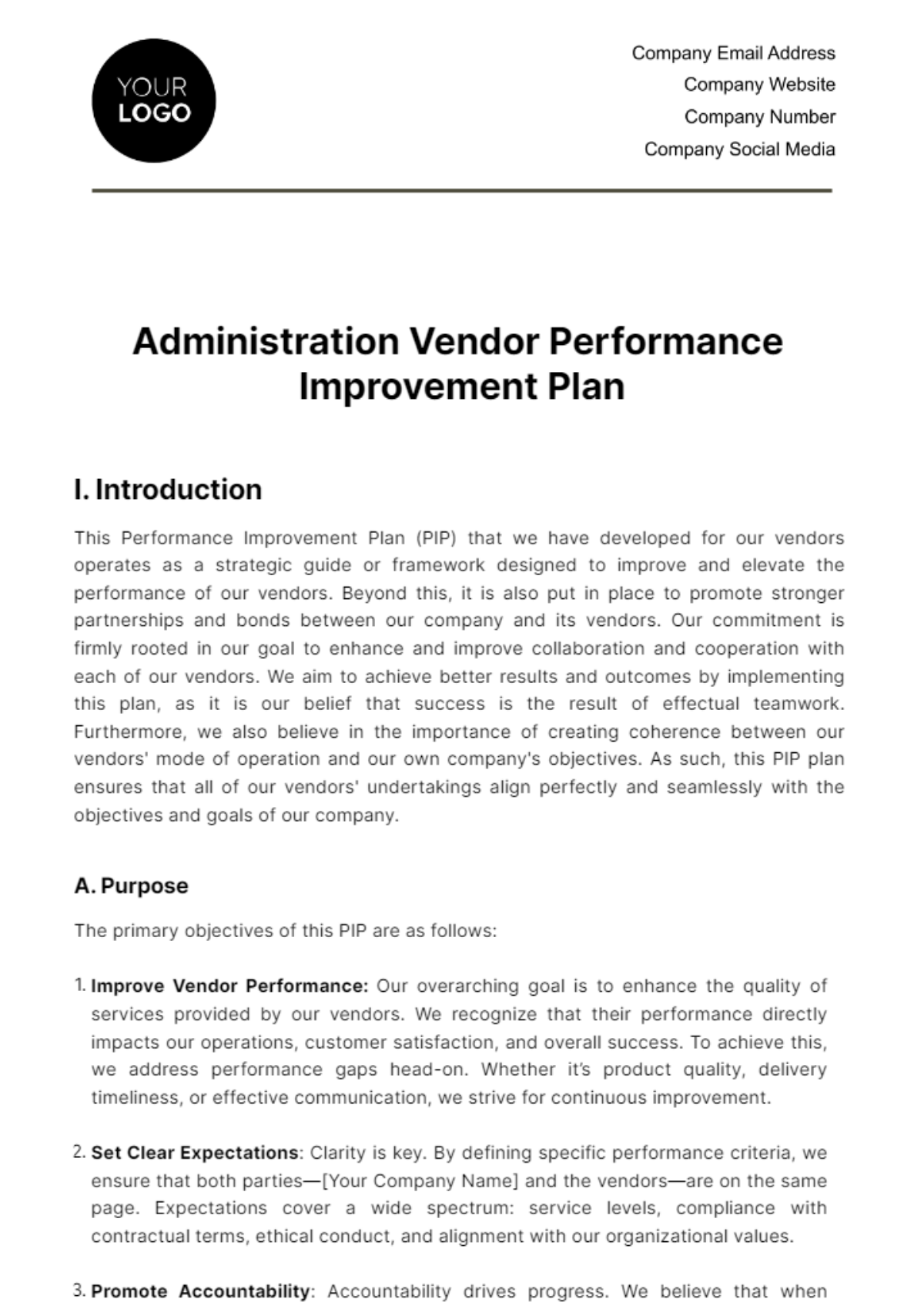
I. Introduction
This Performance Improvement Plan (PIP) that we have developed for our vendors operates as a strategic guide or framework designed to improve and elevate the performance of our vendors. Beyond this, it is also put in place to promote stronger partnerships and bonds between our company and its vendors. Our commitment is firmly rooted in our goal to enhance and improve collaboration and cooperation with each of our vendors. We aim to achieve better results and outcomes by implementing this plan, as it is our belief that success is the result of effectual teamwork. Furthermore, we also believe in the importance of creating coherence between our vendors' mode of operation and our own company's objectives. As such, this PIP plan ensures that all of our vendors' undertakings align perfectly and seamlessly with the objectives and goals of our company.
A. Purpose
The primary objectives of this PIP are as follows:
Improve Vendor Performance: Our overarching goal is to enhance the quality of services provided by our vendors. We recognize that their performance directly impacts our operations, customer satisfaction, and overall success. To achieve this, we address performance gaps head-on. Whether it’s product quality, delivery timeliness, or effective communication, we strive for continuous improvement.
Set Clear Expectations: Clarity is key. By defining specific performance criteria, we ensure that both parties—[Your Company Name] and the vendors—are on the same page. Expectations cover a wide spectrum: service levels, compliance with contractual terms, ethical conduct, and alignment with our organizational values.
Promote Accountability: Accountability drives progress. We believe that when vendors take ownership of their performance, everyone benefits. Through this plan, we establish a structured approach that encourages vendors to actively participate in improvement efforts. Regular monitoring and feedback loops reinforce this accountability.
B. Scope
This PIP applies comprehensively to all vendors engaged in business with [Your Company Name]. It encompasses both existing and new vendor relationships. Our commitment to improvement extends across the entire vendor ecosystem.
Our vendors play a pivotal role in our supply chain, product development, and service delivery. Their performance directly impacts our competitiveness, cost-effectiveness, and customer satisfaction. Therefore, this plan is not merely a document; it’s a strategic initiative that shapes our vendor partnerships.
Recognizing the diversity of our vendors—ranging from small local businesses to multinational corporations—we tailor our improvement strategies to accommodate different contexts. What works for a technology supplier may not be suitable for a raw material provider. Hence, flexibility within the scope is essential.
II. Current Performance Assessment
The table below showcases the performance assessment on vendors:
Vendor | On Time Delivery | Defect Rate | Customer Satisfaction |
|---|---|---|---|
[Vendor Name] | 85% | 3.5% | 4.2 (out of 5) |
Engaging vendors in performance assessment fosters collaboration. It demonstrates our commitment to mutual success. Transparency builds trust. When vendors see our dedication to improvement, they actively participate and contribute.
Timely delivery is essential for smooth operations, meeting customer expectations, and minimizing production delays. Consistently achieving on-time delivery builds trust with our customers and strengthens our supply chain. [Vendor Name] on-time delivery performance stands at 85%, which is below our benchmark of at least 95%. Timely delivery is critical for our production schedules and customer commitments.
The defect rate of 3.5% on the other hand, indicates quality issues in the products delivered. Addressing defects promptly is essential to maintain customer satisfaction and minimize rework costs. Moreover, Customer satisfaction scores reflect how well the vendor’s services align with our customers’ expectations. A higher score indicates positive experiences, while lower scores signal areas for improvement. In the context of customer satisfaction, [Vendor Name] has an average score of 4.2 out of 5, is generally positive. However, specific pain points related to communication responsiveness need attention.
Addressing and identifying the performance gaps within an organization or system leads to the minimization and reduction of potential and inherent risks. Late deliveries, quality issues, or communication breakdowns can disrupt our operations. Root cause analysis helps us tackle issues at their source, preventing recurrence and ensuring long-term stability.
III. Action Steps
A. On-Time Delivery
Clear Communication: Strengthen communication channels with vendors. Ensure they understand delivery expectations, lead times, and critical deadlines. Regularly share production schedules and any changes that may impact delivery timelines.
Supply Chain Visibility: Collaborate with vendors to enhance supply chain visibility. Understand their production processes, lead times, and potential bottlenecks. Identify areas where delays commonly occur and work together to streamline processes.
Contingency Planning: Develop contingency plans for unforeseen events (e.g., natural disasters, transportation disruptions). How will vendors adjust delivery schedules during such incidents? Having backup suppliers or alternative logistics options minimizes risks.
Performance Incentives: We will also consider performance-based incentives. Reward vendors for consistently meeting or exceeding delivery targets. Incentives could include extended contracts, priority orders, or preferential treatment.
Regular Performance Reviews: We will schedule periodic reviews specifically focused on delivery performance. Discuss trends, challenges, and improvement opportunities. Adjust strategies as needed.
B. Defect Rate
Quality Control Processes: The company will collaborate with vendors to enhance quality control processes. Implement rigorous inspections at various stages of production. Define acceptable quality standards and ensure vendors adhere to them.
Root Cause Analysis: Investigate defects systematically. Why are they occurring? Is it a design issue, manufacturing process, or material quality? We will also address root causes to prevent recurrence.
Training and Skill Enhancement: Provide training to vendor teams. Ensure they understand quality requirements and best practices. Invest in skill development related to product assembly, testing, and quality assurance.
Supplier Audits: Conduct regular audits of vendor facilities. Assess their quality management systems. Identify areas for improvement and collaborate on corrective actions.
C. Customer Satisfaction
Feedback Loop: Actively seek feedback from end-users. What do they like? What needs improvement? Use surveys, customer service interactions, and reviews to gather insights.
Service Responsiveness: Improve communication channels for addressing customer inquiries, complaints, and requests. Swift responses demonstrate commitment to customer satisfaction.
Product Customization: Understand customer preferences. Can vendors customize products to meet specific needs? It is also important to ensure tailored solutions enhance satisfaction.
Post-Purchase Support: Extend support beyond the sale. How can vendors assist with installation, maintenance, or troubleshooting? Positive post-purchase experiences build loyalty.
IV. Vendor Performance Improvement Timeline
The following table outlines the strategic timeline for implementing the Vendor Performance Improvement Plan at [Your Company Name]. This plan is designed to enhance collaboration with our vendors, optimize performance, and drive continuous improvement. Each milestone represents a critical step toward achieving our goals.
Timeline | Action Item | Description |
|---|---|---|
Q1 | Customized Improvement Plans | Collaborate with vendors to create individualized improvement plans. Set specific goals, action items, and timelines. Ensure alignment with business objectives. |
During this phase, we will collaborate closely with each vendor to create customized improvement plans. Recognizing that every vendor operates within a unique context, we will tailor our strategies to their specific needs. Here’s how:
We’ll engage in open dialogue with vendors to understand their pain points, strengths, and growth aspirations. Each of our improvement plans will outline actionable steps. These may include process adjustments, training programs, or technology upgrades. We’ll ensure that the action items are realistic, measurable, and aligned with our overall business strategy.
Customized plans are crucial for these plans to foster collaboration. By involving vendors in the planning process, we demonstrate our commitment to mutual success. Moreover, transparency and shared ownership are essential. Vendors should feel empowered to contribute ideas and actively participate in execution.
This timeline is a strategic move as improved vendor performance directly affects our operational excellence. Reliable deliveries, high-quality products, and satisfied customers contribute to overall efficiency. A well-functioning supply chain minimizes disruptions, excess costs, and production delays. In summary, this timeline seeks to ensure that our vendor partnerships thrive, benefiting both parties and contributing to our overall organizational success in the upcoming year.
V. Conclusion
In closing, this Vendor Performance Improvement Plan underscores [Your Company Name]'s unwavering commitment to excellence, collaboration, and continuous growth. Our vendors are not mere transactional partners; they are integral to our ecosystem. By aligning our goals and fostering transparent communication, we create a shared vision for sustainable success. This plan transcends compliance—it embodies our proactive stance toward minimizing environmental impact, optimizing operations, and nurturing a culture of responsibility.
In addition, it is essential to understand that improvement does not denote a fixed endpoint. Instead, it represents a vibrant and ongoing journey that involves continuous growth and development. As we put into action our action steps, we maintain an approach that is not only nimble but also predisposed to modifications and adjustments based on the situations that arise. We continuously incorporate regular checks and balance, integrated with data-driven insights, into our strategy. This aids us in making essential course corrections along the journey. These modifications in our approach ensure that our journey towards achieving vendor excellence remains receptive and responsive, adapting as necessary to meet constantly changing and evolving needs and requirements.
- 100% Customizable, free editor
- Access 1 Million+ Templates, photo’s & graphics
- Download or share as a template
- Click and replace photos, graphics, text, backgrounds
- Resize, crop, AI write & more
- Access advanced editor
Generate your plan with ease and improve vendor performance with the Administration Vendor Performance Improvement Plan Template from Template.net! This customizable template, effortlessly editable with our user-friendly AI Editor Tool, provides a structured format for planning and implementing performance improvement measures, promoting effective vendor management. Edit now to get started!
You may also like
- Finance Plan
- Construction Plan
- Sales Plan
- Development Plan
- Career Plan
- Budget Plan
- HR Plan
- Education Plan
- Transition Plan
- Work Plan
- Training Plan
- Communication Plan
- Operation Plan
- Health And Safety Plan
- Strategy Plan
- Professional Development Plan
- Advertising Plan
- Risk Management Plan
- Restaurant Plan
- School Plan
- Nursing Home Patient Care Plan
- Nursing Care Plan
- Plan Event
- Startup Plan
- Social Media Plan
- Staffing Plan
- Annual Plan
- Content Plan
- Payment Plan
- Implementation Plan
- Hotel Plan
- Workout Plan
- Accounting Plan
- Campaign Plan
- Essay Plan
- 30 60 90 Day Plan
- Research Plan
- Recruitment Plan
- 90 Day Plan
- Quarterly Plan
- Emergency Plan
- 5 Year Plan
- Gym Plan
- Personal Plan
- IT and Software Plan
- Treatment Plan
- Real Estate Plan
- Law Firm Plan
- Healthcare Plan
- Improvement Plan
- Media Plan
- 5 Year Business Plan
- Learning Plan
- Marketing Campaign Plan
- Travel Agency Plan
- Cleaning Services Plan
- Interior Design Plan
- Performance Plan
- PR Plan
- Birth Plan
- Life Plan
- SEO Plan
- Disaster Recovery Plan
- Continuity Plan
- Launch Plan
- Legal Plan
- Behavior Plan
- Performance Improvement Plan
- Salon Plan
- Security Plan
- Security Management Plan
- Employee Development Plan
- Quality Plan
- Service Improvement Plan
- Growth Plan
- Incident Response Plan
- Basketball Plan
- Emergency Action Plan
- Product Launch Plan
- Spa Plan
- Employee Training Plan
- Data Analysis Plan
- Employee Action Plan
- Territory Plan
- Audit Plan
- Classroom Plan
- Activity Plan
- Parenting Plan
- Care Plan
- Project Execution Plan
- Exercise Plan
- Internship Plan
- Software Development Plan
- Continuous Improvement Plan
- Leave Plan
- 90 Day Sales Plan
- Advertising Agency Plan
- Employee Transition Plan
- Smart Action Plan
- Workplace Safety Plan
- Behavior Change Plan
- Contingency Plan
- Continuity of Operations Plan
- Health Plan
- Quality Control Plan
- Self Plan
- Sports Development Plan
- Change Management Plan
- Ecommerce Plan
- Personal Financial Plan
- Process Improvement Plan
- 30-60-90 Day Sales Plan
- Crisis Management Plan
- Engagement Plan
- Execution Plan
- Pandemic Plan
- Quality Assurance Plan
- Service Continuity Plan
- Agile Project Plan
- Fundraising Plan
- Job Transition Plan
- Asset Maintenance Plan
- Maintenance Plan
- Software Test Plan
- Staff Training and Development Plan
- 3 Year Plan
- Brand Activation Plan
- Release Plan
- Resource Plan
- Risk Mitigation Plan
- Teacher Plan
- 30 60 90 Day Plan for New Manager
- Food Safety Plan
- Food Truck Plan
- Hiring Plan
- Quality Management Plan
- Wellness Plan
- Behavior Intervention Plan
- Bonus Plan
- Investment Plan
- Maternity Leave Plan
- Pandemic Response Plan
- Succession Planning
- Coaching Plan
- Configuration Management Plan
- Remote Work Plan
- Self Care Plan
- Teaching Plan
- 100-Day Plan
- HACCP Plan
- Student Plan
- Sustainability Plan
- 30 60 90 Day Plan for Interview
- Access Plan
- Site Specific Safety Plan
